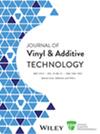Enhancing mechanical properties of polyvinyl chloride: Novel organic-modified cinnamate-intercalated calcium aluminum hydrotalcite as a high-efficiency thermal stabilizer
Abstract
To make the hydrotalcite uniformly dispersed in polyvinyl chloride (PVC) and enhance its thermal stability, cinnamate-intercalated calcium aluminum hydrotalcite (CaAl-cinnamate-LDHs) underwent organic modification with cetyltrimethylammonium bromide/sodium dodecyl sulfate/polyethylene glycol (CTAB/SDS/PEG). The structures of modified hydrotalcite were characterized using x-ray diffractometer, scanning electron microscope, particle size analysis, and water contact angle test. The thermal stability was assessed through thermal aging oven experiment, Congo Red experiment, and thermogravimetric experiment, revealing their exceptional performance. Simultaneously, the synergistic effect of PEG-LDHs with auxiliary thermal stabilizers was examined, with epoxy soybean oil proving to be the most effective, which made the PVC sample incompletely black within 120 min. Mechanical properties and dynamic thermomechanical analysis indicated that the overall mechanical characteristics of the PVC samples with modified hydrotalcite were significantly superior to the unmodified CaAl-cinnamate-LDHs. Additionally, the optical performance test demonstrated excellent transparency in the PEG-LDHs/PVC sample. Through analyzing the thermal stability mechanism, it was indicated that hydrotalcite effectively absorbed HCl. Furthermore, the combination of PEG-LDHs and ESO replaced unstable Cl atoms and reacted with conjugated double bonds, thereby reducing the aging and discoloration of PVC.
Highlights
- The modified hydrotalcite preparation process was simple and easy to operate.
- The CTAB/SDS/PEG-LDHs/PVC samples exhibited excellent thermal stability.
- Mechanical properties of the PVC samples with modified hydrotalcite were significantly superior to the unmodified CaAl-cinnamate-LDHs.

 求助内容:
求助内容: 应助结果提醒方式:
应助结果提醒方式:


